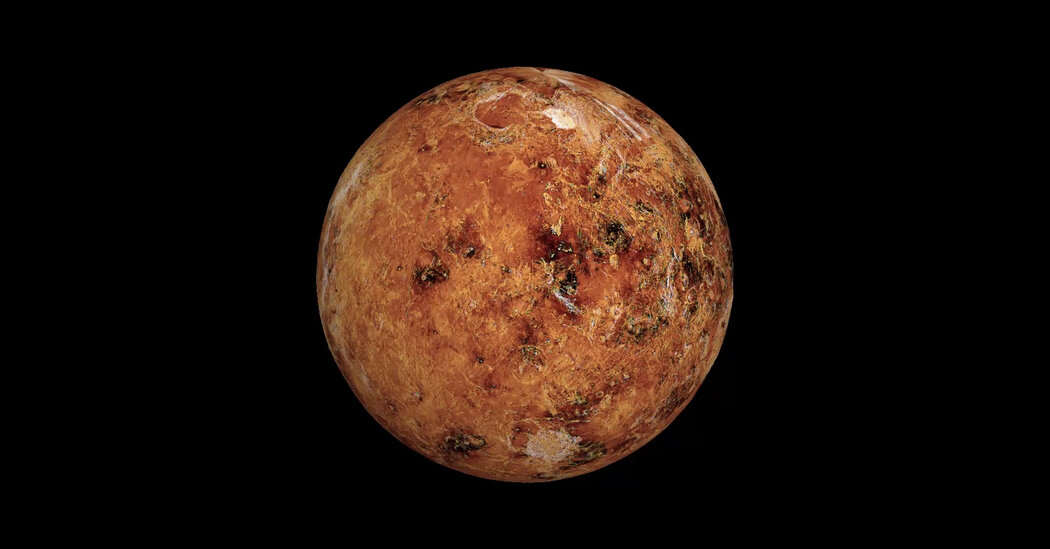Witnessing the blood-red fires of a volcanic eruption on Earth is memorable. But to see molten rock bleed out of a volcano on a different planet would be extraordinary. That is close to what scientists have spotted on Venus: two vast, sinuous lava flows oozing from two different corners of Earth’s planetary neighbor.
“After you see something like this, the first reaction is ‘wow,’” said Davide Sulcanese, a doctoral student at the Università d’Annunzio in Pescara, Italy, and an author of a study reporting the discovery in the journal Nature Astronomy, published on Monday.
Earth and Venus were forged at the same time. Both are made of the same primeval matter, and both are the same age and size. So why is Earth a paradise overflowing with water and life, while Venus is a scorched hellscape with acidic skies?
Volcanic eruptions tinker with planetary atmospheres. One theory holds that, eons ago, several apocalyptic eruptions set off a runaway greenhouse effect on Venus, turning it from a temperate, waterlogged world into an arid desert of burned glass.
To better understand its volcanism, scientists hoped to catch a Venusian eruption in the act. But although the planet is known to be smothered in volcanoes, an opaque atmosphere has prevented anyone from seeing an eruption the way spacecraft have spotted them on Io, the hypervolcanic moon of Jupiter.
In the 1990s, NASA’s spacecraft Magellan used cloud-penetrating radar to survey most of the planet. But back then, the relatively low-resolution images made spotting fresh molten rock a troublesome task.
By using modern software to peruse Magellan’s data, scientists have now found two unambiguous lava flows: one tripping down the flank of Sif Mons, a broad shield volcano, and another winding its way across a western part of Niobe Planitia, a flat plain pockmarked with numerous volcanic mountains.
Many planetary scientists reckoned Venus was effervescing with eruptions. “But it’s one thing to strongly suspect it and quite another to know it,” said Paul Byrne, a planetary scientist at Washington University in St. Louis who was not part of the new study.
Venus lacks the plate tectonics of Earth. But its similarly rocky constitution and comparable size suggests that something must still be cooking inside the sun’s second planet — and it should be volcanically active.
There is indirect supporting evidence: Volcanic gases linger in Venus’s skies, and the way that parts of the planet glow suggests they were painted over by lava in the recent geologic past.
Direct evidence of volcanic fury finally, and surprisingly, emerged in 2023, when researchers caught sight of a volcanic vent doubling in size and possibly filling with lava in old Magellan data. Other scientists still yearned for signs of an unequivocal lava flow, an almost literal smoking gun.
Mr. Sulcanese granted their wish. He found bright, riverlike patches on Sif Mons and Niobe Planitia in later Magellan survey images that weren’t present in earlier data. After carefully ruling out other possibilities, including landslides, his team concluded that lava was the only reasonable explanation.
“Magellan is the gift that keeps on giving,” said Stephen Kane, a planetary astrophysicist at the University of California, Riverside, who was not involved with the new study.
Both lava flows are comparable in size to the output of the Kilauea volcano in Hawaii during its three-month paroxysm in 2018. And using these two eruptions, the study’s authors estimate that there is considerably more eruptive activity than previously assumed — and that it’s happening elsewhere on the planet in the present day.
“Venus is active,” said Giuseppe Mitri, an astronomer also at the Università d’Annunzio and an author of the study.
More important, volcanically speaking, Venus “is Earth-like,” said Anna Gülcher, a planetary scientist at the California Institute of Technology who was not involved with the work.
The result also complicates the tentative detection of phosphine in Venus’s atmosphere; phosphine is a substance that is usually associated on Earth with living things. But other explanations for its possible presence on Venus couldn’t be ruled out. Volcanic activity can also make phosphine, but rebuttals to that idea have suggested that Venus simply doesn’t have sufficient volcanism to make it.
“Well, apparently there is,” Dr. Kane said.
The only way to find better answers — on phosphine, Venus’s volcanic cadence, its cataclysmic transformation — is to revisit the planet. Fortunately, a fleet of new spacecraft is set to do just that in the 2030s.
While we wait, Magellan’s memories will continue to offer unexpected gifts.
“We can start to think of Venus as a living, breathing world,” Dr. Byrne said.
